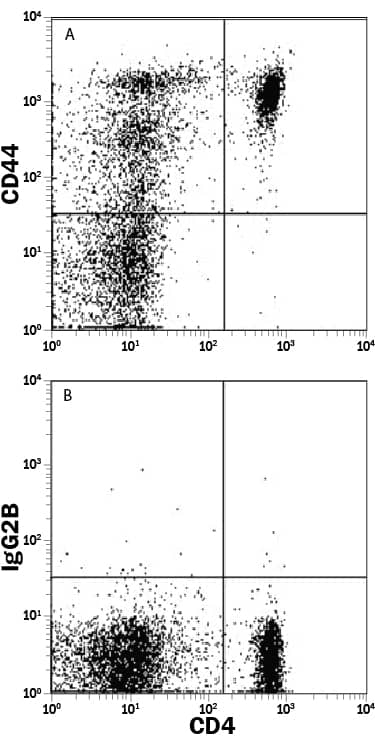CD44 Antibody (740017) [PE]
Novus Biologicals, part of Bio-Techne | Catalog # FAB6577P

Key Product Details
Species Reactivity
Applications
Label
Antibody Source
Concentration
Product Specifications
Immunogen
Gln22-Thr223 (predicted)
Accession # P26051
Specificity
Clonality
Host
Isotype
Scientific Data Images for CD44 Antibody (740017) [PE]
Detection of CD44 in Rat Splenocytes by Flow Cytometry.
Rat splenocytes were stained with Anti-Rat CD4 APC-conjugated Monoclonal Antibody and either (A) Mouse Anti-Rat CD44 PE-conjugated Monoclonal Antibody (Catalog # FAB6577P) or (B) Mouse IgG2BPhycoerythrin Isotype Control (Catalog # IC0041P). View our protocol for Staining Membrane-associated Proteins.Applications for CD44 Antibody (740017) [PE]
Flow Cytometry
Sample: See below
Formulation, Preparation, and Storage
Purification
Formulation
Preservative
Concentration
Shipping
Stability & Storage
Background: CD44
CD44 is a ubiquitously expressed protein that is a major receptor for hyaluronan and exerts control over cell growth and migration (1-5). Mouse CD44 has a 22 amino acid (aa) signal sequence, an extracellular domain (ECD) that contains a 100 aa hyaluronan-binding disulfide-stabilized link region plus a 48-463 aa stem region, a 21 aa transmembrane domain, and a 72 aa cytoplasmic domain. Within the stem, ten variably spliced exons (v1-10, exons 6-15) produce multiple protein isoforms (1‑5). The standard or hematopoietic form, CD44H, does not include the variable segments (1‑5). Cancer aggressiveness and T cell activation have been correlated with expression of specific isoforms (2, 4). With variable N- and O-glycosylation and splicing within the stalk, CD44 can range from 80 to 200 kDa (1, 2). Within the N‑terminal invariant portion of the ECD (aa 23-222), rat CD44 shares 91% and 75% aa sequence identity with corresponding mouse and human CD44, respectively. The many reported functions of CD44 fall within three categories (1, 2). First, CD44 binds hyaluronan and other ligands within the extracellular matrix and can function as a “platform” for growth factors and metalloproteinases. Second, CD44 is a co-receptor that modifies activity of receptors including MET and the ErbB family of tyrosine kinases. Third, the CD44 intracellular domain links the plasma membrane to the actin cytoskeleton via the ERM proteins, ezrin, radixin and moesin. CD44 can be synthesized in a soluble form (4) or may be cleaved at multiple sites by either membrane-type matrix metalloproteinases, or ADAM proteases to produce soluble ectodomains (6, 7). The cellular portion may then undergo gamma secretase-dependent intramembrane cleavage to form an A beta‑like transmembrane portion and a cytoplasmic signaling portion that affects gene expression (8, 9). These cleavage events are thought to promote metastasis by enhancing tumor cell motility and growth (1, 2, 6).
References
- Pure, E. and R.K. Assoian (2009) Cell. Signal. 21:651.
- Ponta, H. et al. (2003) Nat. Rev. Mol. Cell Biol. 4:33.
- Screaton, G.R. et al. (1992) Proc. Natl. Acad. Sci. USA 89:12160.
- Lynch, K.W. (2004) Nat. Rev. Immunol. 4:931.
- Yu, Q. and B.P. Toole (1996) J. Biol. Chem. 271:20603.
- Nagano, O. and H. Saya (2004) Cancer Sci. 95:930.
- Nakamura, H. et al. (2004) Cancer Res. 64:876.
- Murakami, D. et al. (2003) Oncogene 22:1511.
- Lammich, S. et al. (2002) J. Biol. Chem. 277:44754.
Alternate Names
Gene Symbol
UniProt
Additional CD44 Products
Product Documents for CD44 Antibody (740017) [PE]
Product Specific Notices for CD44 Antibody (740017) [PE]
This product is for research use only and is not approved for use in humans or in clinical diagnosis. Primary Antibodies are guaranteed for 1 year from date of receipt.
